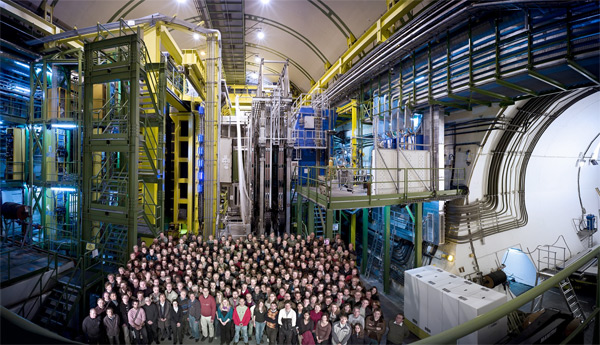A Flavour of Particle Physics
Postcards from the Energy Frontier by Prof Jon ButterworthNot unlike beer, it seems Neutrinos come in all manner of flavours that beg sampling…

I just got back from the bi-annual high-energy physics conference of the European Physical Society in Ghent, Belgium. At the end of the meeting I gave a “highlights” talk, and there were some serious highlights (beyond the obvious cricket-related ones), so this seems like a good opportunity to share a few. I won’t go into many details, but will hopefully give you a snapshot over the next few posts of where we are in our understanding of the fundamental constituents of matter, and the forces by which they interact – and of where that understanding is currently changing.
The basic particles of matter come in three progressively heavier “generations”. The most common is the first generation, which contains the electron, and the up and down quarks which make up the protons and neutrons inside atomic nuclei.
The other generations are essentially heavier copies, and the label we give to particles to distinguish between the generations is called “flavour” (for no obvious taste-related reason).
According to our best theory (yes, it’s that Standard Model again) some processes are blind to flavour, so it should for example make no difference in those processes whether an electron is produced, or whether its heavy flavour cousin the muon emerges. Some experiments, especially LHCb at CERN, have been observing marginal differences in such processes, which could be a sign of some new heavier particles or new forces, which break the flavour rules and are not present in the Standard Model. Although no single measurement is conclusive, the pattern is suggestive. LHCb has more data in hand and more coming, and the Belle II experiment, which has just started up in Japan, will have something to say. It’s very much a “watch this space” situation.

The LHCb collaboration seen inside the LHCb cavern (Pic: CERN)
The flavour structure of the quarks also breaks the symmetry between matter and antimatter – so-called CP-violation. We do not really understand how the universe came to be composed primarily of matter, since according to the Standard Model, the big bang should have created equal amounts of matter and antimatter. That’s one reason studying CP-violation is interesting. The LHCb experiment has recently observed CP-violation in the decays of hadrons with charm in them for the first time; previously this had only been seen when strange or bottom quarks were involved.
We also had a Belgian Beer lecture and tasting. Some very special flavours there.
Neutrinos are also about flavour really. In the Standard Model as originally conceived, flavour was the only way to distinguish between the three kinds of neutrino, because they were all massless. We now know they have mass, but (as with the quarks) the different masses do not line up neatly with the different flavours; there is a mixing. In fact the mixing is much bigger for neutrinos than it is for quarks.
The Cosmic Shambles Network relies on your support on pledges via Patreon so we can continue to provide great, new, exciting content without the need for third party ads or paywalls.
For as little as $1 a month you can support what we do and get some great rewards for doing so as well. Click the Patreon logo to pledge or find out more.
A consequence of this is that there is room for more CP violation, similar to that seen in quark mixing. Whether nature has taken this opportunity or not is one of the currently outstanding big questions.
Our measurements of neutrino mixing only measure mass differences, not the absolute mass of the neutrinos. We know there is one small gap, and two bigger gaps, between the masses of the three neutrinos. This means there are two possible ways the neutrino masses can be arranged, a so-called “normal” hierarchy, with two lighter neutrinos close together in mass and one heavier one further above, or an “inverted” hierarchy, with two heavier ones close together, with a lighter one further below. Which of these options is present in nature is another big open question.

A selection of Neutrino flavours…
Within an extended Standard Model, it is possible to fit all the data to try and determine these aspects, along with the other parameters. Combining new data from T2K and Nova experiments (which use neutrinos produced by accelerators) and experiments using neutrinos produced by nuclear power stations, we see that there probably is some CP violation there, perhaps quite a lot. We also see that the normal hierarchy is favoured over the inverted one. Definitive statements and more precise measurements will come with more data, and with the DUNE and HyperK experiments under construction in the US and Japan.
That’s enough for now but I plan to follow up with more highlights, not so flavourful, over the next week or so.
For more details on the above, all the slides, with references, are available from the conference web site http://eps-hep2019.eu/, and proceedings will appear in due course.
 Professor Jon Butterworth is a physics professor at University College London and a researcher on the ATLAS experiment at CERN involved with, amongst other things, the discovery of the Higgs Boson. He is the author of two popular science books Smashing Physics and A Map of the Invisible. Postcards From the Energy Frontier is the successor to Jon’s hugely successful blog for The Guardian, Life and Physics. He is @jonmbutterworth on Twitter.
Professor Jon Butterworth is a physics professor at University College London and a researcher on the ATLAS experiment at CERN involved with, amongst other things, the discovery of the Higgs Boson. He is the author of two popular science books Smashing Physics and A Map of the Invisible. Postcards From the Energy Frontier is the successor to Jon’s hugely successful blog for The Guardian, Life and Physics. He is @jonmbutterworth on Twitter.
If you would like to reuse this content please contact us for details
Subscribe to The Cosmic Shambles Network Mailing list here.
The Cosmic Shambles Network relies on your support on pledges via Patreon so we can continue to provide great, new, exciting content without the need for third party ads or paywalls.
For as little as $1 a month you can support what we do and get some great rewards for doing so as well. Click the Patreon logo to pledge or find out more.


I am not either a scientist nor someone who understands mathematics (I am a Mexican psychologist and stand-up comedian, and this is no joke)
However last year I came across with the particle fever documentary and I was fascinated by the sheer curiosity and passion for knowledge shown by the physicists in the movie, specially Nima Arkani-Hamed and lately I have listened many of his lectures on youtube (So if someone ever talks to him, tell him he has a personal stalker in Cancun!) although I understand maybe 10 percent of what he says.
I admire people like him, J Maldacena, S Dimopoulos, etc, because of their true passion about things that we, the regular people, can´t even see or comprehend most of the time, and also their selfishness about their findings, they seem very uninterested in fame and fortune and if their theories end up being proven in their lifetime, they regard it just as something for humanity!
That is why from my little turf and from my small mind I will always applaud people like Nima Arkani Hamed, however yesterday I read Sabine Hossenfelder blog and was so sad to read that this part of the human condition that I called “only my opinion matters” was plastered all over that blog.
Wasn’t the porpoise of science, the ultimate way to find the truth? I can only hope that in your field, vanity and closed-minded way of approaching their work is at a minimum
Kind Regards
Hi Diana,
Thanks for the comment. I think you are right in the way you see the ideals of science, though obviously it is done by people, who also have other motivations and are fallible. There is definitely vanity and closed-mindedness around.
That said, science should be self correcting because it is empirical. In my opinion such correction mostly comes from data, though mathematical rigour is also a good constraint.
Nima and others can be inspirational, and I liked his piece in CERN courier recently, for example: https://cerncourier.com/a/in-it-for-the-long-haul/
Regarding Hossenfelder, I think she has some valid criticisms of some of the more hubristic attitudes some particle physicists have taken, but I dislike the way she tend to impute bad faith on others (even when they may have made mistakes) and I have doubts about her understanding of the motivation behind experimental exploration, to be honest. But then, that’s my opinion 🙂 I wrote something more about this for example here: https://lifeandphysics.com/2019/03/18/running-over-the-same-old-ground/
Cheers,
Jon